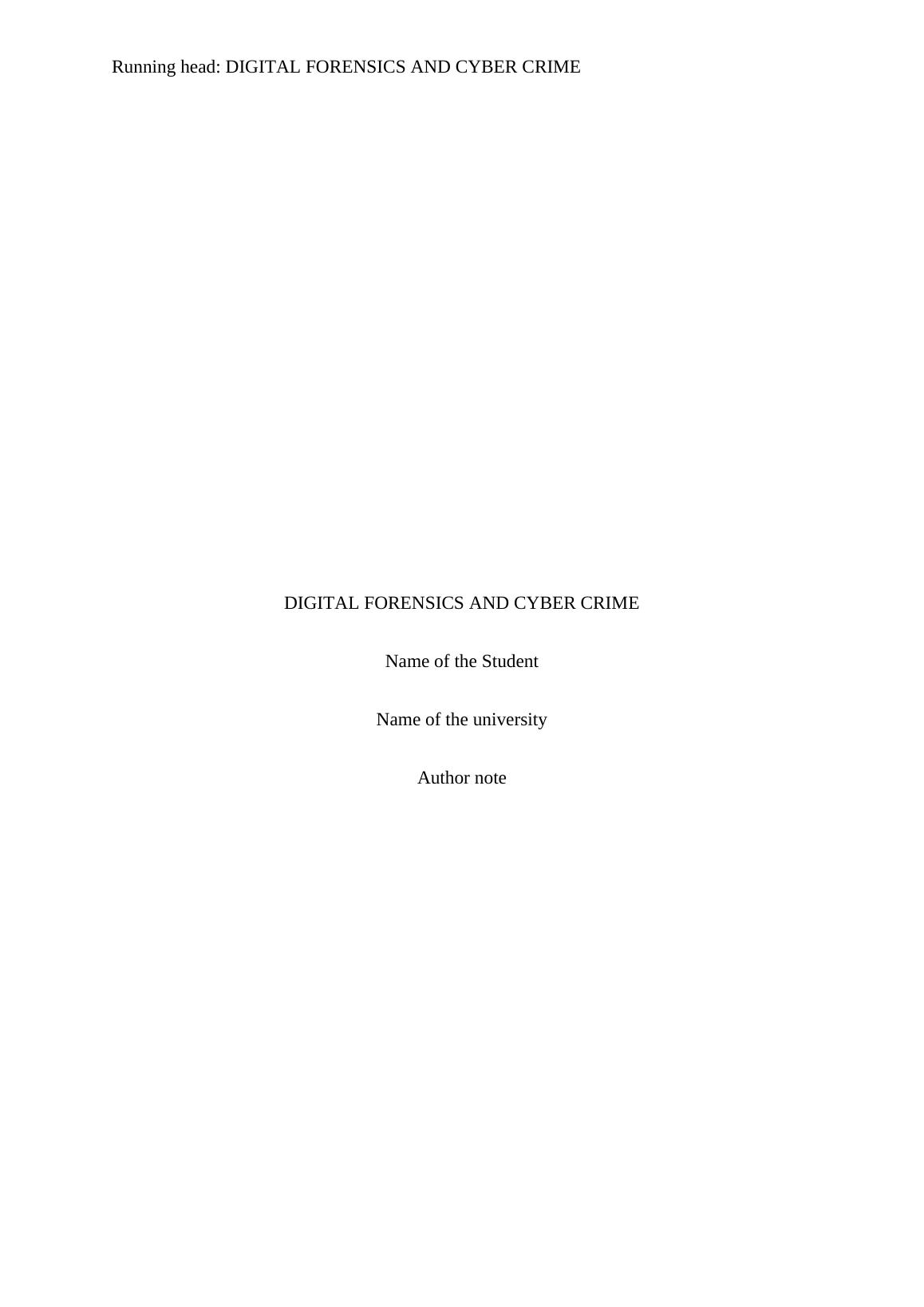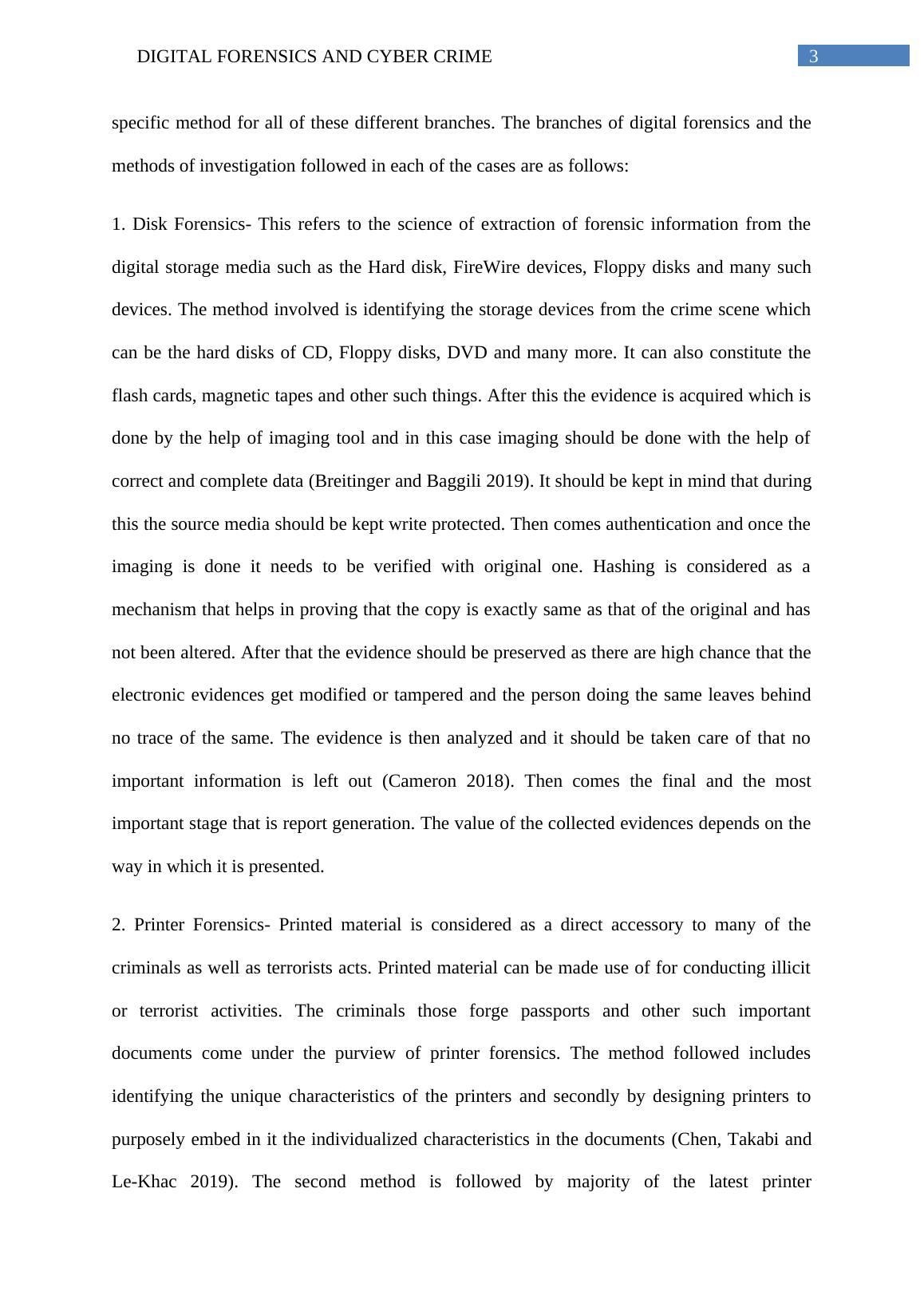Digital Forensics and Cyber Crime | Discussion
Added on 2022-08-30
12 Pages2877 Words72 Views
Running head: DIGITAL FORENSICS AND CYBER CRIME
DIGITAL FORENSICS AND CYBER CRIME
Name of the Student
Name of the university
Author note
DIGITAL FORENSICS AND CYBER CRIME
Name of the Student
Name of the university
Author note

1DIGITAL FORENSICS AND CYBER CRIME
Table of Contents
Introduction................................................................................................................................2
Impact of cybercrimes to digital forensics investigation methods.............................................2
Digital forensic principles, standards and techniques................................................................6
Conclusion..................................................................................................................................8
References..................................................................................................................................9
Table of Contents
Introduction................................................................................................................................2
Impact of cybercrimes to digital forensics investigation methods.............................................2
Digital forensic principles, standards and techniques................................................................6
Conclusion..................................................................................................................................8
References..................................................................................................................................9

2DIGITAL FORENSICS AND CYBER CRIME
Introduction
At present the scenario is such that there is always a need for a computer or another
such digital device in the realms of criminal investigations. While conducting forensic
analysis there are many mistakes made. Forensic has been a important concept since its
inception and refers to scientific tests and the techniques that are made use of in relation to
detection of various crimes. Digital forensics is concerned about the evidences form the
computer systems that are accepted by the court only if they are convincing enough and can
be relied upon. It deals in science of locating, extracting as well as analyzing various types of
data collected from different devices which are then interpreted by the specialists to draw
conclusions from the same (Alenezi et al. 2017). In the broader sense digital forensics can be
considered as the process involved in investigation of a computer system so that cause of a
certain incident can be determined from the same. Computer forensics is referred to a specific
process that helps in recognizing, protecting, extracting and archiving electronic evidences
existing on computer systems or the associated peripherals. In this paper, the various impacts
of cybercrimes to the digital forensics investigation methods will be discussed upon. The
discussion will also include evaluation of existing digital forensic principles, standards and
associated techniques.
Impact of cybercrimes to digital forensics investigation methods
Digital Forensics has a broad scope and is thus divided into different branches so that
in each of the knowledge areas greater knowledge base can be facilitated. The various
branches of digital forensics are as disk forensics, network forensics, database forensics,
scanner forensics, multimedia forensics, digital music device forensics, PDA forensics and
printer forensics (Bates, Pohly and Butler 2016). In the sphere of cybercrimes there is a
Introduction
At present the scenario is such that there is always a need for a computer or another
such digital device in the realms of criminal investigations. While conducting forensic
analysis there are many mistakes made. Forensic has been a important concept since its
inception and refers to scientific tests and the techniques that are made use of in relation to
detection of various crimes. Digital forensics is concerned about the evidences form the
computer systems that are accepted by the court only if they are convincing enough and can
be relied upon. It deals in science of locating, extracting as well as analyzing various types of
data collected from different devices which are then interpreted by the specialists to draw
conclusions from the same (Alenezi et al. 2017). In the broader sense digital forensics can be
considered as the process involved in investigation of a computer system so that cause of a
certain incident can be determined from the same. Computer forensics is referred to a specific
process that helps in recognizing, protecting, extracting and archiving electronic evidences
existing on computer systems or the associated peripherals. In this paper, the various impacts
of cybercrimes to the digital forensics investigation methods will be discussed upon. The
discussion will also include evaluation of existing digital forensic principles, standards and
associated techniques.
Impact of cybercrimes to digital forensics investigation methods
Digital Forensics has a broad scope and is thus divided into different branches so that
in each of the knowledge areas greater knowledge base can be facilitated. The various
branches of digital forensics are as disk forensics, network forensics, database forensics,
scanner forensics, multimedia forensics, digital music device forensics, PDA forensics and
printer forensics (Bates, Pohly and Butler 2016). In the sphere of cybercrimes there is a

3DIGITAL FORENSICS AND CYBER CRIME
specific method for all of these different branches. The branches of digital forensics and the
methods of investigation followed in each of the cases are as follows:
1. Disk Forensics- This refers to the science of extraction of forensic information from the
digital storage media such as the Hard disk, FireWire devices, Floppy disks and many such
devices. The method involved is identifying the storage devices from the crime scene which
can be the hard disks of CD, Floppy disks, DVD and many more. It can also constitute the
flash cards, magnetic tapes and other such things. After this the evidence is acquired which is
done by the help of imaging tool and in this case imaging should be done with the help of
correct and complete data (Breitinger and Baggili 2019). It should be kept in mind that during
this the source media should be kept write protected. Then comes authentication and once the
imaging is done it needs to be verified with original one. Hashing is considered as a
mechanism that helps in proving that the copy is exactly same as that of the original and has
not been altered. After that the evidence should be preserved as there are high chance that the
electronic evidences get modified or tampered and the person doing the same leaves behind
no trace of the same. The evidence is then analyzed and it should be taken care of that no
important information is left out (Cameron 2018). Then comes the final and the most
important stage that is report generation. The value of the collected evidences depends on the
way in which it is presented.
2. Printer Forensics- Printed material is considered as a direct accessory to many of the
criminals as well as terrorists acts. Printed material can be made use of for conducting illicit
or terrorist activities. The criminals those forge passports and other such important
documents come under the purview of printer forensics. The method followed includes
identifying the unique characteristics of the printers and secondly by designing printers to
purposely embed in it the individualized characteristics in the documents (Chen, Takabi and
Le-Khac 2019). The second method is followed by majority of the latest printer
specific method for all of these different branches. The branches of digital forensics and the
methods of investigation followed in each of the cases are as follows:
1. Disk Forensics- This refers to the science of extraction of forensic information from the
digital storage media such as the Hard disk, FireWire devices, Floppy disks and many such
devices. The method involved is identifying the storage devices from the crime scene which
can be the hard disks of CD, Floppy disks, DVD and many more. It can also constitute the
flash cards, magnetic tapes and other such things. After this the evidence is acquired which is
done by the help of imaging tool and in this case imaging should be done with the help of
correct and complete data (Breitinger and Baggili 2019). It should be kept in mind that during
this the source media should be kept write protected. Then comes authentication and once the
imaging is done it needs to be verified with original one. Hashing is considered as a
mechanism that helps in proving that the copy is exactly same as that of the original and has
not been altered. After that the evidence should be preserved as there are high chance that the
electronic evidences get modified or tampered and the person doing the same leaves behind
no trace of the same. The evidence is then analyzed and it should be taken care of that no
important information is left out (Cameron 2018). Then comes the final and the most
important stage that is report generation. The value of the collected evidences depends on the
way in which it is presented.
2. Printer Forensics- Printed material is considered as a direct accessory to many of the
criminals as well as terrorists acts. Printed material can be made use of for conducting illicit
or terrorist activities. The criminals those forge passports and other such important
documents come under the purview of printer forensics. The method followed includes
identifying the unique characteristics of the printers and secondly by designing printers to
purposely embed in it the individualized characteristics in the documents (Chen, Takabi and
Le-Khac 2019). The second method is followed by majority of the latest printer

End of preview
Want to access all the pages? Upload your documents or become a member.
Related Documents
File System Forensic Analysis Reportlg...
|15
|4700
|348
What is Digital Forensics?lg...
|4
|737
|20
FCM 753 Digital Forensic AN OVERVIEWlg...
|21
|1819
|31
Digital Forensics : Files Systemlg...
|4
|761
|30
Data acquisition methods for digital forensicslg...
|11
|1180
|18
Digital Forensics Assignment PDFlg...
|22
|6638
|49
